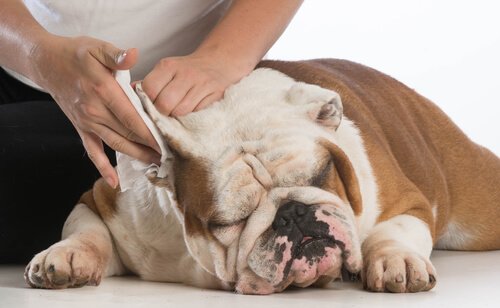Protect Your Dog’s Ears During Summer

You must protect your dog’s ears during the summer, as these are the months when the heat and humidity favor the growth of dangerous microorganisms that could even cause deafness in the animal. This condition is known as canine otitis.
Protect your dog’s ears effectively
Infections in our pet’s ears are caused by inflammation inside their ear canal, a fundamental organ, not only for our ability to listen, but also to maintain balance.
If you don’t make a timely diagnosis and start to treat it immediately, then the infection can be dangerous. It’ll spread to the inner ear of the animal, and it’ll cause deafness over time. Otitis is frequent in summer, not only because of the heat but also because of the high humidity from baths.
Causes of otitis
Otitis is caused by bacteria and fungi that reach the ear of the dog and infect it. The high summer temperatures, together with the humidity produced after a bath, generate the optimal conditions for these microorganisms to grow and develop. They multiply quite fast inside the ear and produce infections.
An excess of wax in our dog’s auditory canals is another sign that our canine friend has an ear infection. You also usually get an unpleasant, strong smell.

Symptoms of ear infections in dogs
The most visible symptoms are those that result from the discomfort and itching that ails our pet. We will notice that it shakes its head and scratches its ears rather frequently. Also if we touch behind its ears, the dog will yelp or cringe in pain.
Guidelines for preventing otitis
After each bath in a pool, natural pond, beach, or after a daily wash, we need to dry our dog’s ears very well. As we have said above, the humidity will cause fungi and bacteria to reproduce, and it will infect the ears.
Protect the dog’s ears during bathing. A simple cotton plug will keep the water from going inside the ear canals.
Also, spikes and other long plants often stick to a dog’s hair and sometimes they also get inside its ears. To prevent this, trim the hair around the ears as much as possible to keep it out of the ears. Do a full body check-up after returning from walks.
Dogs with long, pendulous ears, are more prone to these kinds of infections. This is due to poor air circulation, among other things. Precautions taken to avoid the risk of otitis are very important.

Usual cleaning of your dog’s ears
To clean a dog’s ears, avoid internal cleaning beyond what you can actually see; use specific products for dog hygiene as well. Don’t use cotton swabs, these can cause problems.
If your dog has been diagnosed with otitis before, then an otoscopic examination should be done twice a year in order to avoid relapse.
The ear has a self-cleaning mechanism based on the migration of epithelial cells from the tympanic membrane. These travel from the ear canal to the external atrial canal. In this way, the migration of cells acts as a removal element for the cerumen, which is a substance composed of lipids (fats), cell debris and microorganisms that inhabit the ear canal area.
When there’s inflammation in the ear canal, it alters the natural cleaning system –and this leads to the accumulation of cerumen. It also leads to the environmental conditions that are most conducive to the production of these infections. To avoid them, carry out regular checkups so you can detect ear inflammation as soon as possible.
As for cotton swabs, these should be used only in the folds of the ear, and never inserted inside. Otherwise, you will just push the cerumen inwards.
All cited sources were thoroughly reviewed by our team to ensure their quality, reliability, currency, and validity. The bibliography of this article was considered reliable and of academic or scientific accuracy.
- Small Animal Ear Diseases
Gotthelf L
Small Animal Ear Diseases (2005) Published by Elsevier Inc. - Preventive ear care for dogs and cats.
Mansfield P
The Veterinary clinics of North America. Small animal practice, vol. 18, issue 4 (1988) pp. 845-858
